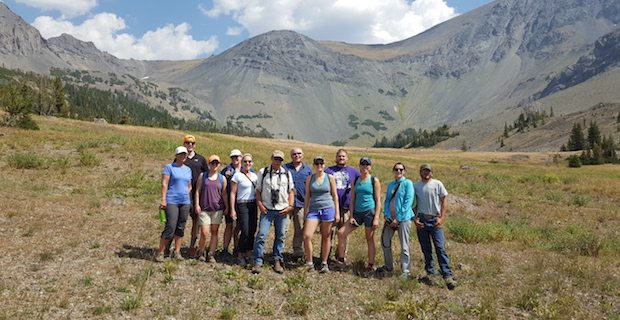
Last month, nine outstanding leaders from CEF member companies — chosen from a highly competitive field of applicants — joined wildlife ecologist Arthur Middleton and CEF Leadership Council Member Jean Sweeney, for a trip to Cody, WY and Yellowstone National Park to explore the connections between wildlife, conservation, development and business. The winners were deemed by the selection jury as being at “an inflection point in their lives or careers with regard to sustainability—ready and eager to take their sustainability leadership to the next level within their communities and/or organizations—as well as being strong team players accomplished in setting ambitious goals and getting results.”
During this week-long journey, participants experienced the Wyoming wilderness where Buffalo Bill camped and hunted over 100 years ago. They traveled on horses through the spectacular Absaroka Range, surrounded by peaks that stretch up to twelve thousand feet above sea level, and examined the challenges of balancing the fast pace of development while respecting and learning from the ecosystems that have defined the region. Participants met with key local leaders – ranchers, government officials, business leaders and conservationists – to learn more about the leadership skills and sustainability expertise required to move forward even in areas of significant conflicting interests. Here are the reflections from the winners:

Michael Brewer, Senior Software Engineer, Salesforce
After meeting with stakeholders from federal, state, county, NGO, and private concerns, I am in awe of the complexity of the issues that face maintaining Yellowstone National Park and its greater ecosystem.
I have a two critical observations from the experience. The first is many do not understand the complexity of the issues facing the ecosystem, especially how important private ranch land is to the Greater Yellowstone Ecosystem. There are entities whose singular mission is removing ranch cattle from public land, but their shortsightedness fails to understand is that these large tracts of nearly pristine land are integral to the ungulate herds that make the ecosystem their home.
The elk migrate across the park, US forests, BLM land, state, and private acreage because these lands provide something important to their survival (namely shelter and/or sustenance) and they require the ranch lands to remain intact in order to preserve their migration routes. If the ranches did not have access to public land leases, many of them would no longer be viable as a business and hundreds of thousands of acres would fragment while the land went towards the next most profitable use: development.
Development on these acres would interrupt the ungulate migrations and impact the health of the herds, causing unknown devastation. This in turn affects the large carnivores that depend on the herds as a food staple. This would increase the number of conflicts between humans and bears, cougars, & wolves, further impacting large carnivore numbers as natural food sources dwindled and predation into human habitat forced private parties and authorities to intervene using lethal means. It is a vicious cycle that feeds itself and the ecosystem would likely crumble.
Unfortunately, we cannot depend on the government to purchase these areas (federal services are already starved for funding, are slow to move, and meet resistance for controlling what they already have) nor can we depend on some billionaire to save it. NGOs with lots of capital might be part of the solution, but we need to foster greater cooperation between stakeholders and provide incentives for private owners to shelter (or at least ignore) migrating species. Which brings me to my next observation.
There is little to no cooperation and communication between federal agencies, let alone state & local governments or private interests. There is nominally a Greater Yellowstone Coordinating Committee that comprises all the federal stakeholders (2 National Parks, 5 US Forests, 3 BLM regions, & 2 Wildlife Refuges), but their funding is minimal and everyone is protecting their own interests, so very little intra-service work actually happens. Ranches may not be aware of methodologies used by their neighbors that successfully reduce predation or otherwise help its operations coexist with the ecosystem that also works with their bottom line.
The GYCC needs to be revamped and empowered so it can solve big issues. It needs to operate fairly autonomously and have the authority to actually set mandates. I also think it needs to provide seats to state and county stakeholders and maybe have some sort of buy-in for private interests (landowners, outfitters, NGOs, concerned citizens, etc.) and provide a network of communication between all stakeholders to facilitate communication and the dissemination of knowledge. And it needs funding. I don’t have a complete picture of what this coalition would look like or how it would operate, legally, but surely there are some examples elsewhere where a similar process has worked.
There are some big issues that Yellowstone needs to tackle if its wants to exist for another 100 years. Climate change is happening and it needs to adapt to that. Development never ceases and it needs to form a buffer against it. And it has a visitor problem… the people are actually managing to “love it to death.” I think many of the solutions to these problems can be solved by partnering with external stakeholders including other federal agencies, state & county agencies, as well as private concerns such as ranches, outfitters, homeowners, and commercial entities that rely on park traffic for business.
Keeping these observations in mind when approaching sustainability efforts in our own companies will be important. It is to understand our own greater ecosystems and realize we are not islands. From a Salesforce perspective, this very much aligns with our Ohana culture in that our greater ecosystem includes our employees, customers, partners, and communities where we work and do business. Our greatest successes will come from leveraging and engaging with our ecosystem stakeholders and fostering trust and transparency via communication, innovation, and giving back.
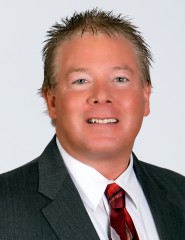
Patrick Browne, Director, Global Sustainability, UPS
When I first learned I had been nominated to apply for the 2016 Corporate Eco Forum Sustainability Leadership Development Challenge, I was flattered. As I read through the background and description of the program, that flattered feeling shifted to excitement. The possibility of experiencing Yellowstone National Park through the eyes of wildlife ecologist Arthur Middleton is a once in a lifetime experience, and I knew I must sharpen my pencil as I wrote my application essay to truly stand out from the crowd. Upon learning I was one of only nine selected for the Challenge, the excitement immediately turned into a feeling of being honored.
Having never spent time in this part of the country, I didn’t really know what to expect, except for the fact that I was going to visit and feel Yellowstone National Park for the first time. I read and studied to prepare for the trip, but it didn’t help. This was an experience that I could not prepare for. To experience the Yellowstone backcountry on horseback with Wes Livingston (outfitter and esteemed storyteller), with Mark Bruscino (Wyoming Game and Fish Large Carnivore Expert), and with Rosie the Mule, this trip was not only enlightening and inspiring, but entertaining as well. For three days, I felt like I was exploring the Wild West for the first time, similar to the settlers in the 1800’s. Unlike the early settlers, though, I only had one worry: to watch for grizzlies over my left shoulder.
Many people visit this region of the country specifically for Yellowstone National Park and see this majestic natural wonder as the highlight of their trip. Through this experience, I now understand that Yellowstone is only one part of a much larger ecosystem. The park relies so heavily on the surrounding towns, states, and local leaders, businesses, and ranchers. It is a great example of a symbiotic relationship, and the importance of collaboration between all of these parties is critical.
Before the trip, I knew little about the migration patterns of the Yellowstone wildlife. When we explored Arthur Middleton’s “Invisible Boundaries” exhibit at the Buffalo Bill Center of the West Museum in Cody, Wyoming, I realized there is no boundary for nature. Given this, we must ask ourselves how we can continue to sustain the beauty of Yellowstone and the wildlife, while continuing to develop the local economies and communities. Through this experience, I learned that we need balance, we need compromise, and we need collaboration. What we don’t need are fences.
The honor that I felt going into this trip has now changed to me be inspired. Inspired by all the people I met, inspired by knowing that true collaboration can make a difference, inspired by the free spirit of Wes and Rosie, inspired by the energy one gets from being a part of nature, and inspired to determine my role in this ecosystem.
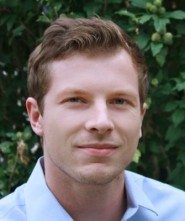
Greg Hintler, Senior Strategy Analyst, NRG Energy
Yellowstone is a miracle. It is America’s oldest National Park and one of the wildest, most beautiful places in the US. Its wilderness and beauty attract both humans and wild animals. In the park itself, the encounter (at a distance) between humans and animals is intended – seeing bears, elk, or buffalo is one of the primary reasons people come to Yellowstone.
Outside of the park, often the opposite is the case. The encounter between wild fauna and civilization poses dangers to humans and livestock, can spread disease, and creates competition over grazing land – all of which could impact local economic activity.
Over the course of the trip, we learned from rangers, environmentalist, government agencies, and scientists from the area about the challenges they face reconciling the preservation of this unique ecosystem with recreational and economic activities. The viewpoints of how to best manage this complex system, as well as the interests and objectives of the different parties were often contradictory.
Yet, everyone we talked to I heard speaking with deep respect about the other stakeholders and saw great awareness for the problems each parties is facing. And this I think is one key ingredient to the successful management, both in the greater Yellowstone ecosystem and in business: respect and empathy. It is the prerequisite for any fruitful discussion, which in turn is the prerequisite to identify common ground, build trust, and create a space to jointly shape pathways and a vision for a future that recognizes those conflicting needs, but goes beyond narrow self-interests or short-term objectives.
It will require enormous stewardship and collaboration to preserve Yellowstone and its surroundings as a place that provides the natural and economic resources to sustain a healthy coexistence of humans and wildlife. But I am optimistic that the local and national leaders we met will be a positive force in keeping Yellowstone one of the most special places I have visited.

Laura Keenan, Corporate Sustainability Officer and VP, Fidelity Real Estate Company
As I look back on our week in the greater Yellowstone area I am reminded, and still amazed, how far from a natural habitat my daily existence in Boston (MA) is. Despite that sad reality, I was struck by the similarities of the way in which we are all trying to solve integrally related problems. As we are all forced to do more with less, we are collectively focused on encouraging change and innovation for the common good, as our environmental challenges cannot be solved alone. In one way or another, we all discussed the importance of building a trusting, respectful and collaborative environment in order to effectively build relationships, educate, influence and “tell our story”. Whether the audience is a global corporation, a regional entity, or a local community, the same core relational skills are required to collectively influence in the way that we all aspire to.
As a relatively small service provider, Fidelity Investments’ environmental challenges are not at the same scale, nor as critical, as those that many of our Corporate EcoForum colleagues or those in the greater Yellowstone community face. As big or as small as each of our efforts are, inevitably they will impact one another. Together, we can make a difference, positively and proactively changing our environment.
Over the last several months as I have transitioned into my new corporate sustainability role, at times, the issues and responsibilities of it have seemed overwhelming. Many thanks to the Corporate EcoForum community for the opportunity to participate in this program which has enabled me to gain a broader perspective into so many key issues and the ways in which we can collectively achieve them. It was truly a once-in-a-lifetime experience!

Ann Lott, Director, Corporate Social Responsibility Marketing, Dell
The CEF Leadership Development trip was truly a once-in-a-lifetime experience. And it wasn’t the amazing setting of Cody, Wyoming with the beautiful scenery every which way we turned. Or my horse, Tucker, who stuck with me through the ups and downs of a 34 mile journey on horseback. Or the amazing group of people selected to be a part of the development program, who all taught me so much. Or the amazing food at the ranches and even 17 miles in the wilderness….some of the best cinnamon rolls I’ve ever eaten (and I’ve eaten plenty) were made on a skillet over a campfire! Or even the animals we viewed in their natural habitat….grizzly bears eating off moth sites, elk, bison, pronghorns, deer, rabbits, beaver, golden eagles, fox or coyote (it’s still up for debate), etc.
This trip was amazing because of the access we had to some of the most influential and knowledgeable people in the Greater Yellowstone area. Arthur Middleton known for his ‘trans-boundary wildlife migrations in the Greater Yellowstone Ecosystem’ exposed us to the issues facing the wildlife of Yellowstone National Park. He also connected us with Wes Livingston, true mountain man and heralded net gunner, and his crew. Wes’s love and respect for the land and animals are unparalleled. He’s truly one with nature, and THE guy you’d want with you on any outdoor adventure. Mark Bruscino, grizzly bear expert, has devoted his life to reestablishing the grizzly bear population in Wyoming. He provided great insight into grizzly bears, the challenges faced and the excruciating decisions after human-bear conflict.
In addition to these folks, we met ranchers from small and large ranches. They shared the complexities of ranching – from the grass to the genetics to predation – providing a new appreciation for the beef on the table. Dan Wenk, Director of Yellowstone National Park, candidly discussed the challenges of managing the park, and his goals to protect and preserve the land and wildlife, while educating and delivering a great experience for the visitors of the park. And lastly, we met a number of influential people in the Cody, Wyoming area working to preserve and protect the land and wildlife.
A key takeaway is that we need national awareness of the importance of preserving more than just the lands that have been set aside. In Cody, we witnessed ranchers, locals, oufitters and ecologists all genuinely trying to do the right thing even though their views are not always aligned. However, that doesn’t stop collaboration because everyone has an appreciation and love for the land and wildlife. It’s a great reminder that no matter how small, we all need to do our part to make the world a better place. Global sustainability issues are much larger than any one company, but we all need to continue to put forth the effort to do the right thing and collaborate with as many community members, competitors, customers and partners to drive positive change. I left this trip with a renewed optimism that we can do just that!
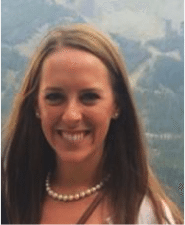
Lauren Sutkowski, Supply Chain Sustainability Specialist, Dow Chemical
CEF’s Sustainability Leadership Development Challenge was a one in a lifetime experience, and exceeded my (already high) expectations. Being immersed in the beautiful landscapes of Wyoming, we had the opportunity to meet with stakeholders and local leaders to learn about the delicate balance between conservation and development, and got unique insight into the relationships between a national park and the surrounding wildlife and ranchers.
Between grizzly bear sightings, horseback riding, the Invisible Boundaries museum exhibit and meeting with local ranchers, we were able to disconnect from “real life” to create meaningful relationships with people from diverse backgrounds. Group discussions about conservation, leadership and personal values provided valuable insight from inspiring and incredible people working in sustainability across all different industries. I returned from the trip feeling a renewed sense of personal responsibility and a stronger desire to use business to drive positive change.
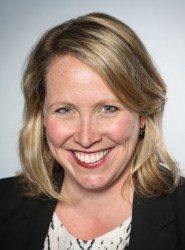
Heather Tansey, Head of Sustainability Business Development, 3M
When accepted to be part of the Corporate EcoForum 2016 Leadership Development program, I knew it was a special honor. I looked forward to the opportunity to emerge myself in a new sustainability challenge– Balancing the needs of wildlife and humans alike in a complex ecosystem of ranchers, a national park, tourists, migrating elk, grizzly bears, and more. I expected the experience to yield changes in my perspective and insights along the way. I suspected these learnings would apply in my different, but equally complex, interconnected system of corporate sustainability. In the end, I gained that experience and more. My fondest memories will be the friendships built and conversations along the way. Thanks for a great week.
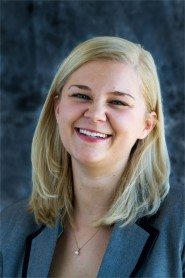
Chelsea Wulff, Sustainability Specialist, BASF
Participating in CEF’s Sustainable Leadership Development Program reminded me of many things I am lucky to have had in my life: an appreciation for wildlife, numerous family vacations to Yellowstone National Park, and last but not least adequate horseback riding skills. The element that struck me most, beyond the pristine landscape of the United States that many never see, was those chosen to convene. The leaders surrounding me were extremely intelligent, easygoing, inquisitive, and communicative – and that’s the tip of the iceberg. I was floored by the questions asked of our guides, local leaders and each other – that in itself was a learning experience!
Our group’s organization, led by Amy O’Meara and Jean Sweeney seemed to be a perfect match for our group. On top of their expertise, we had local wildlife ecologist Arthur Middleton hand pick intriguing Greater Yellowstone local leaders and businessmen, government staff, and outfitters for us to meet which continued to impress and engage our group during our time together.
The moments I will remember most happened around a campfire, 17 miles deep into Pahaska Sunlight Trail in the Absorka mountain range, discussing sustainability: our ideal world, our purpose, and moving the needle as an individual in large, global, and complicated businesses. It was refreshing to quickly connect off the grid with likeminded peers who I now consider mentors and more importantly, friends. As a group we challenged each other to think about different industries, perspectives, and aligning our values with our own companies.
I begrudgingly boarded my plane wishing for more time: for more delicious meals, more intellectual conversations, and many more grizzly bears and campfire stories. I returned to my office with aspirations to continue searching for ways to connect with organizations preserving our natural environment. I look forward to sharing my experiences and collaborating with CEF members on sustainability project and initiatives in the future.
